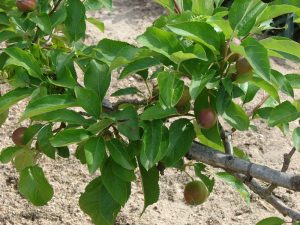Q. Do you have a suggestion of a good/easy to grow fruit trees in the Indianapolis area? Any tips on the “how to” will be appreciated. – N.D.
A. A dwarf, scab- resistant apple cultivar would likely be the best adapted of the fruit trees for the central Indiana area. There are quite a few cultivars to choose from. Most apple cultivars require cross pollination from a compatible cultivar in order to reliably set fruit. It is best to use as pollinizers those cultivars that bloom about the same time as the main cultivars. Purdue has a number of resources for the “how to.”
Purdue Fruit Gardening Resources:
https://hort.purdue.edu/ext/PurdueFruitResources.html
Purdue Apple Cultivars for Indiana:
https://hort.purdue.edu/ext/HO-165.pdf
Purdue Managing Pests in the Home Fruit Planting:
http://www.extension.purdue.edu/extmedia/ID/ID-146-W.pdf
Midwest Home Fruit Production Guide:
https://extensionpubs.osu.edu/midwest-home-fruit-production-guide/
Facts for Fancy Fruit (newsletter for commercial and advanced amateur fruit growers:
https://fff.hort.purdue.edu/
Q. We have moles everywhere we look. We have tried poison, traps and noisemakers and nothing helps. They are in our neighbors’ yards and many more yards in the area. I have cats and a dog, and they just keep getting worse. What can I do? – MR
A. Moles are a perennial pest in many Indiana landscapes. Moles primarily feed on insects, but they do damage lawns and sometimes landscape plants during burrowing activity. The burrowing results in the characteristic soil mounds and raised ridges. Moles feed primarily on earthworms, beetle grubs and ants. Less frequently, they might consume various seed and vegetable matter. They usually do not eat bulbs or the roots of garden plants. Mice may use the mole runs and are often the culprits when there is occasional damage to roots and bulbs in flower and vegetable gardens.
Trapping is the most reliable method of control, according to USDA Animal Damage Control experts, but can be a challenge. It is essential to locate the main active runways. USDA/Purdue publication ADM-10 on moles provides detailed information on how to successfully trap these frustrating furries.
